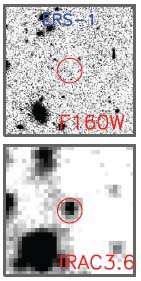Mysterious red galaxies

(PhysOrg.com) -- Perhaps the most astonishing and revolutionary discovery in cosmology was Edwin Hubble's observation that galaxies are moving away from us with velocities that are proportional to their distances.
This discovery provides the underpinning of the big bang picture of creation in which the universe is expanding, and has been doing so for 13.7 billion years. Einstein, Lemaitre and other scientists in the last century pointed out that in an expanding universe distant galaxies would appear red as a result of their apparent motions. But, while relativity does predict red galaxies, other causes of redness might also be at work. Galaxies might be very dusty, for example, since dust tends to block visible light but allow longer wavelength infrared to pass (thus making the galaxies appear reddish in color). They might be actively forming new stars, since that process heats up local dust and makes galaxies luminous in the infrared. Or, they might contain many old stars which have evolved to become red, as for example in the case of Betelgeuse in Orion.
CfA astronomers Jiasheng Huang and Giovanni Fazio, and their four colleagues, knew they were on to something quite mysterious, however, when they spotted four galaxies in their Spitzer Space Telescope infrared images that were so red they were completely undetectable at visible and near-infrared wavelengths. Even the Hubble Space Telescope was unable to detect anything, meaning that these new galaxies are as much as sixty times brighter in the infrared than at the longest wavelength to which Hubble's near-infrared camera is sensitive.
The astronomers modeled all of the various options and combinations to explain their data. They rule our that the sources are simply dusty, because then they should have been seen in other galaxy surveys. The most likely explanation so far is that these galaxies are red for a combination of three reasons: they are far enough away that their light has been traveling for more than about 12.3 billion years, they harbor a substantial amount of star formation, and they contain a significant number of old, evolved stars. While one or another of these conditions has been seen in galaxies before, this is the first time they have all been found to jointly contribute substantively.
The conclusions are notable for two other reasons. The universe was less than about one billion years old when these galaxies emitted their light, and for them to contain old stars must imply these stars formed very soon after the big bang, an important conclusion if true. Secondly, these galaxies must be quite bright and massive to be detectable at this great distance, yet finding four of them presents problems for theories of how early galaxies formed (and the initial indications are that many more will be found now that it is known they exist).
Provided by Harvard-Smithsonian Center for Astrophysics












.jpg)





